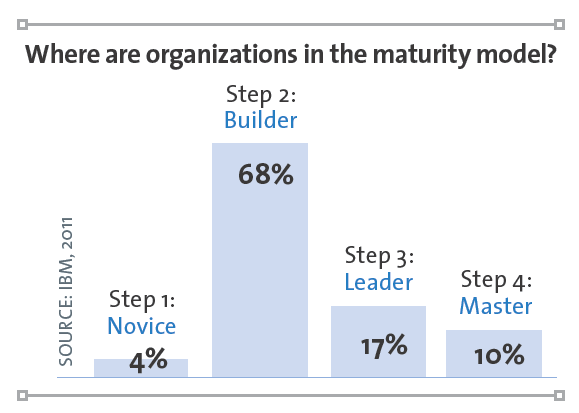“Analytics and business intelligence will be the top technology priorities for CIOs this year,” writes Patrick Thibodeau. His conclusion was drawn from “Gartner Inc.’s annual survey of IT executives.” [“The top 10 tech priorities of CIOs,” ComputerWorld, 18 January 2012] According to Thibodeau, business analytics only ranked fifth on last year’s list of priorities. This dramatic jump indicates just how important analyzing big data is becoming. Also high on the priorities list are business analytics enablers, namely: cloud computing (including software-as-a-service (SaaS), which ranked third) and collaboration and workflow technologies (which ranked fourth). As the business world moves rapidly into the era of big data, it is no surprise that learning something from and doing something with that data is becoming increasingly important.
Siddharth Taparia, senior director for business analytics with SAP AG, told the staff at SupplyChainBrain that companies “are showing keen interest in business analytics” because they “have invested heavily in new information technology, including systems for enterprise resource planning and supply-chain planning and execution.” Without good analysis, they simply can’t “handle the wealth of data required to support such systems.” [“Why Business Analytics Are Critical to the Supply Chain,” 26 September 2011] The article continues:
“At the most basic level, business analytics are a means of measuring supply-chain performance. They employ dashboards, reports, graphs and charts, based on handful of key performance indicators. They include such elements as forecast accuracy, days sales outstanding and inventory days of supply. ‘From executives in the boardroom to people on the shop floor, everybody can have the information they need to do their jobs easier,’ Taparia says.”
That statement is true only if companies implement technologies that permit them to integrate their data sources, analyze it correctly, and are able to provide the right information to the right person in the right format at the right time. Perhaps the hardest thing for companies to do is integrate data that comes in a variety of formats so that individuals throughout the company are all using the same ground truth. The article continues:
“The first step toward embracing business analytics is to secure the data that underlies global operations. More of it has been generated in the last year than the previous few decades combined, according to Taparia. ‘What’s important is to have it presented to the decision-maker in a way that’s timely and relevant.’ With the data in place, companies need to examine the areas they wish to measure, manage and optimize. Business analytics can be a valuable tool for mapping business priorities to the available data.”
Taparia doesn’t literally mean that “the data” should be “presented to the decision-maker in a way that’s timely and relevant.” He means that “results” from analyzing that data should be presented to decision-makers in a way that makes it easier for them to make informed decisions. Databases today are so large that even the most sophisticated analytic programs only sample the data for insights. Taparia also told the SupplyChainBrain staff that “business analytics can also be a critical tool in protecting against natural disasters, which have the potential to shut down entire supply chains.”
According to the Global Intelligence Alliance, companies too often limit the utility of business intelligence and analytics by focusing them primarily on marketing. [“Market Intelligence Should Be a Tool for Supply Chain Managers, Not Just for Sales,” SupplyChainBrain, 27 October 2011] The article reports:
“Manufacturers will need to invest prudently in market intelligence for better informed decision making, in the face of the sluggish U.S. economy, the European debt crisis and new emerging markets and competitors. Companies would be well advised to use market intelligence systems and techniques, and apply them equally to supply chain management and product development. This however, would require a major change in thinking because market intelligence is mostly regarded as part of the marketing function, even though it is often linked to strategic planning.”
The conclusions stated above came from the 2011 Global Market Intelligence Survey. “The study, from the Global Intelligence Alliance, surveyed 989 companies across North America, Latin America, Europe and Asia Pacific, of which 192 respondents were global manufacturing and industrial companies.” According to the article, the study was conducted online about a year ago. Some of the study’s key survey findings included:
“• Over 80% of manufacturing and industrial companies surveyed have systematic market intelligence operations in place. Of those that don’t, 31% surveyed intend to launch one within 12 months.
“• The majority set up their market intelligence functions under Sales & Marketing (39%).
“• Compared to some other industries, the market intelligence functions at manufacturing and industrial companies work closest to their CEOs and prefer small teams.
“• About half (57%) use market intelligence only on an ad-hoc basis.
“• The average budget spent on market intelligence, including internal human resources costs, is about 1 million Euros or 1.4 million US dollars.
“• 63% intend to increase their investments in market intelligence over 2012-2013. However, this percentage is moderate compared to other industries, such as the Chemicals (79%) and Automotive (69%) industries.”
Considering the potential ROI that can be made from implementing good business intelligence and analytic processes, I find it surprising that so many companies have made such modest investments. A report by IDC concludes, “Effective mining of … ‘big data’ can yield invaluable insights, but many organizations are challenged to make sense of information coming from multiple sources and in multiple, often unstructured formats.” [“Business Analytics: The Path from Novice to Master,” IDC, 2011] The report continues:
“Business analytics isn’t just a product you buy. It’s collaboration among stakeholders to apply a variety of technologies, tools and processes to data, with the goal of deriving insight that can help develop understanding and drive future business planning. And business analytics isn’t something organizations become expert in overnight. There is a definite maturity curve, with history, experience, stakeholder buy-in and the right technology tools being the drivers that can move organizations from business analytics novice to business analytics master.”
The report discusses the results of a ComputerWorld survey on the topic of business analytics. Participants in the survey indicated that they desire a variety of outcomes from business analytic technologies. The report identifies some of the significant desired outcomes:
“More than half of the respondents, 57 percent, said improving the ability to forecast trends was very important to their organization’s use of business analytics. Half, 50 percent, also deemed decreasing business costs and improving operational efficiency very important. Close to half (47 percent) identified aligning with corporate strategy and objectives and 45 percent saw help with identifying risk as very important to their organizations.”
Those desired outcomes aren’t surprising. Drawing on recent supply chain literature, I’ve written posts on every one of those topics. The point being that there are a lot things on decision-makers’ minds and they need help to make better informed decisions. Tracy Harris, senior manager of business analytics at IBM, told the report’s authors, “People are understanding the value business analytics can bring, especially the value of using analytics across the enterprise and not just as a point solution in specific areas.” She continued:
“As organizations reach higher maturity levels, they begin to better collaborate and understand that all departments of an organization hold key information that can collectively produce insight and visibility for competitive advantage. Take customer analytics, for example: This isn’t just one data set and department; you need to bring together data that may be captured by sales systems, marketing systems, operational systems or call centers as well as unstructured data of many types. We are seeing people quickly expand their use of business analytics to include business intelligence, financial performance management solutions, social media analytics and predictive analytics to ensure that they have visibility not just across all relevant data but also across all time horizons—past, present or future.”
As noted earlier, if big data and the analysis drawn from it are going to be of value across an organization, it must integrated and widely available. That is not as easy as it sounds. The report details some of the challenges noted by survey participants.
“When asked to name the top three challenges their organizations were facing, more than half of the respondents, 53 percent, said poor data quality was slowing their progress toward business analytics maturity. The ability to effectively make sense of large volumes and varieties of data takes training, and 50 percent of the respondents said a skills shortage was hampering their company’s business analytics progress. To effectively derive meaning from it, organizations must be looking at all the data they generate, including data in legacy business applications.”
IBM’s Harris told the report’s authors that many companies don’t understand the value of the data they collect and, therefore, can’t make a business case for investing in business analytics. That could prove to be a huge mistake in the long run. The report describes a four-tier business analytic maturity model: Novice, Builder, Leader, and Master. The report describes each of these levels:
“Novice. Organizations have only a limited historical view of data, often through spreadsheets. They are aware that they can do better.
“Builder. Organizations collaborate across teams, typically within one department, with both a historical and a current view as well as views trending over past and future time periods.
“Leader. These organizations employ defined operational and financial metrics across more than one department. They use integrated, data-driven planning and align resources and predictive models to understand what-if performance and risk scenarios.
“Master. Organizations set top-down goals, allocating resources based on priorities that can shift in response to real-time data. Everyone knows the objectives and how they can collaborate across the organization to achieve them.”
Drawing from an IBM study, the report notes that most companies appear to be at the Builder level as shown in the following graphic.

Obviously, as president of a company that provides business analytic solutions, I believe that companies need to become Leaders and Masters in this maturity model paradigm. The reason that so many companies are currently found at the Builder level is that mastering data integration and analysis is a challenging, if worthwhile, endeavor. The focus at Enterra Solutions® is helping companies use big data to improve supply chain operations as well as enhance marketing opportunities. Got questions? Enterra Solutions has answers.




